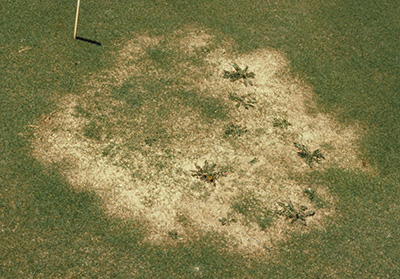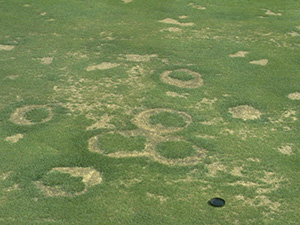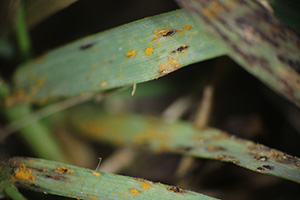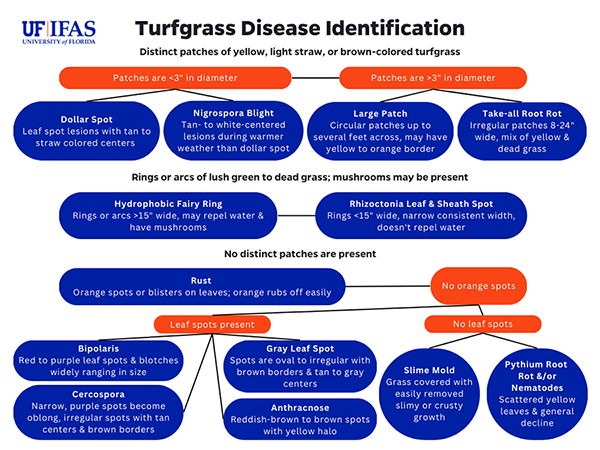Lawn Diseases

Take-all root rot. Photo: William M. Brown Jr., Bugwood.org
It is alarming to suddenly find yellow patches in your lawn or a strange film covering the foliage. These are just a couple symptoms of lawn diseases. It can be tricky to tell the difference between a disease issue, pest infestation, or improper maintenance, but this overview will give you the tools to identify symptoms, make an educated guess, and confirm with your county Extension office.
What is a Disease?
Lawn diseases are caused by a pathogen interacting with the turfgrass to disrupt growth and alter its appearance. In Florida, most turfgrass diseases are caused by fungi. Each type of disease is only active for a few months each year, and the emergence of diseases depends on the environment and stress.
If you notice an issue with your lawn, rule out physical destruction or a disorder first. Physical destruction includes pesticide damage, mowing too short, or leaking fuel. A disorder means improper environmental conditions or maintenance, such as nutritional deficiencies, cold damage, or drought. These problems may cause similar symptoms as diseases, or even occur at the same time as a disease because they weaken the turfgrass and make it susceptible to pathogens.
Disease Identification
Documentation is a necessary part of your management plan. Throughout the year, document any disease outbreaks, where they were located, and the stress factors. This can help you predict and prevent future disease problems since they tend to appear in the same places or under the same conditions each year.
The two main symptoms of turfgrass diseases are a circular patch that is no longer uniformly green and/or spots on the foliage. If you spot these signs, further examine the leaves and roots of your turf for more symptoms. Compare your findings with the flow chart below to identify which disease your lawn may be suffering from.
There is one exception to the fungal cause: in South Florida, mosaic virus is a major concern. Symptoms include the yellowing of leaf blades in distinct mosaic patterns, and it does not typically occur in patches. Unfortunately, fungicides are not effective against it. You can learn more about this relatively new disease concern here: Sugarcane Mosaic Virus in Florida Turfgrass.
Once you’ve identified one of these potential culprits, contact your county Extension office for final confirmation. Agents will let you know if testing is needed and which of the following control practices you should consider.
Cultural Control
Cultural control methods refer to actions that are taken simultaneously with fungicide treatments or ahead of time to prevent known annual disease issues. Below are some steps you can take against lawn diseases.

Hydrophobic fair ring. Photo: William M. Brown Jr., Bugwood.org
- Turfgrass selection: Choose a turfgrass that is well-suited to your location and environmental conditions. An unsuitable variety will be more susceptible to disease.
- Mowing practices: Keep mower blades sharp and mow no more than one third of the leaf each time. Don’t mow when grass is wet because this can spread pathogens. If a disease is present, raise your mowing height and mow any areas with an active disease last. Wash or blow equipment off to remove any diseased leaf clippings once you’re done.
- Water management: Irrigate only when necessary, i.e., when leaf blades are curling. Check your irrigation system to make sure you are watering uniformly across your lawn. You should run it long enough to just saturate the root zones. Irrigating early in the morning or late in the evening can help reduce disease because the lawn is already wet with dew at those times. Prolonging or creating wet periods can favor disease.
- Nutrition management: Apply the minimal amount of nitrogen needed for your turfgrass species. Not enough or excess nitrogen can lead to disease. Apply as much potassium as nitrogen to prevent stress. Increase potassium applications in diseased areas. Use slow-release fertilizers, if possible.
- Thatch management: Some thatch in a lawn is healthy, but too much nitrogen or water can cause excessive spongy thatch buildup. Excess thatch causes the mower to sink and cut grass too short, leading to stressed turf. Remove any excessive thatch and alter management practices to prevent it from happening again.
- Soil conditions: Compacted soil, soil with high pH, and salty soil are conditions that can promote disease. Aerify to reduce compaction, apply acid fertilizers or lime to correct high or low pH issues according to soil test results, and where salinity is an issue, consider a more salt-tolerant turf species. Don’t bury building materials in the landscape, and remove any existing materials, which can cause waterlogging and other problems. Sometimes leftover materials from construction projects become buried over time, so check any problem areas by inserting a metal rod into the soil to see if it hits anything.
Chemical Control

Rust fungus. Photo: Clarissa Balbalian, Mississippi State University, Bugwood.org
Chemical control involves using fungicides to suppress or slow pathogen growth or to stop the fungus from reproducing. Note that applying fungicides will not get rid of current symptoms; the only way your lawn will look healthy again is when new growth appears.
Fungicide considerations
- If you have a recurring disease problem, fungicides can be used preventively.
- Don’t broadly apply fungicides; only treat areas with known problems.
- Always follow label directions to prevent safety risks, pollution, and wasting money.
- Alter your maintenance practices to allow the fungicide to work. For example, mowing right after applying a fungicide can remove it before it has a chance to do its job.
For more information on fungicides, check out the Ask IFAS publication, Homeowner's Guide to Fungicides for Lawn and Landscape Disease Management.
Biological Control
A healthy microbiome is an excellent disease preventative. Beneficial microorganisms can out-compete pathogens for food, produce chemicals that inhibit pathogen growth, and occupy real estate on the turfgrass blades so there is no space for the pathogens. The best way to help these microorganisms flourish is to limit pesticide use as much as possible and promote healthy, vigorous turfgrass growth through best management practices.
Lawn diseases can be tricky to pinpoint, but the experts at your county Extension office are available to help diagnose and treat any turfgrass issues you encounter.
Also on Gardening Solutions
- Best Management Practices for Your Lawn
- How to Take a Turfgrass Sample
- Large Patch in Florida Lawns
- Sugarcane Mosaic Virus in Florida Turfgrass


